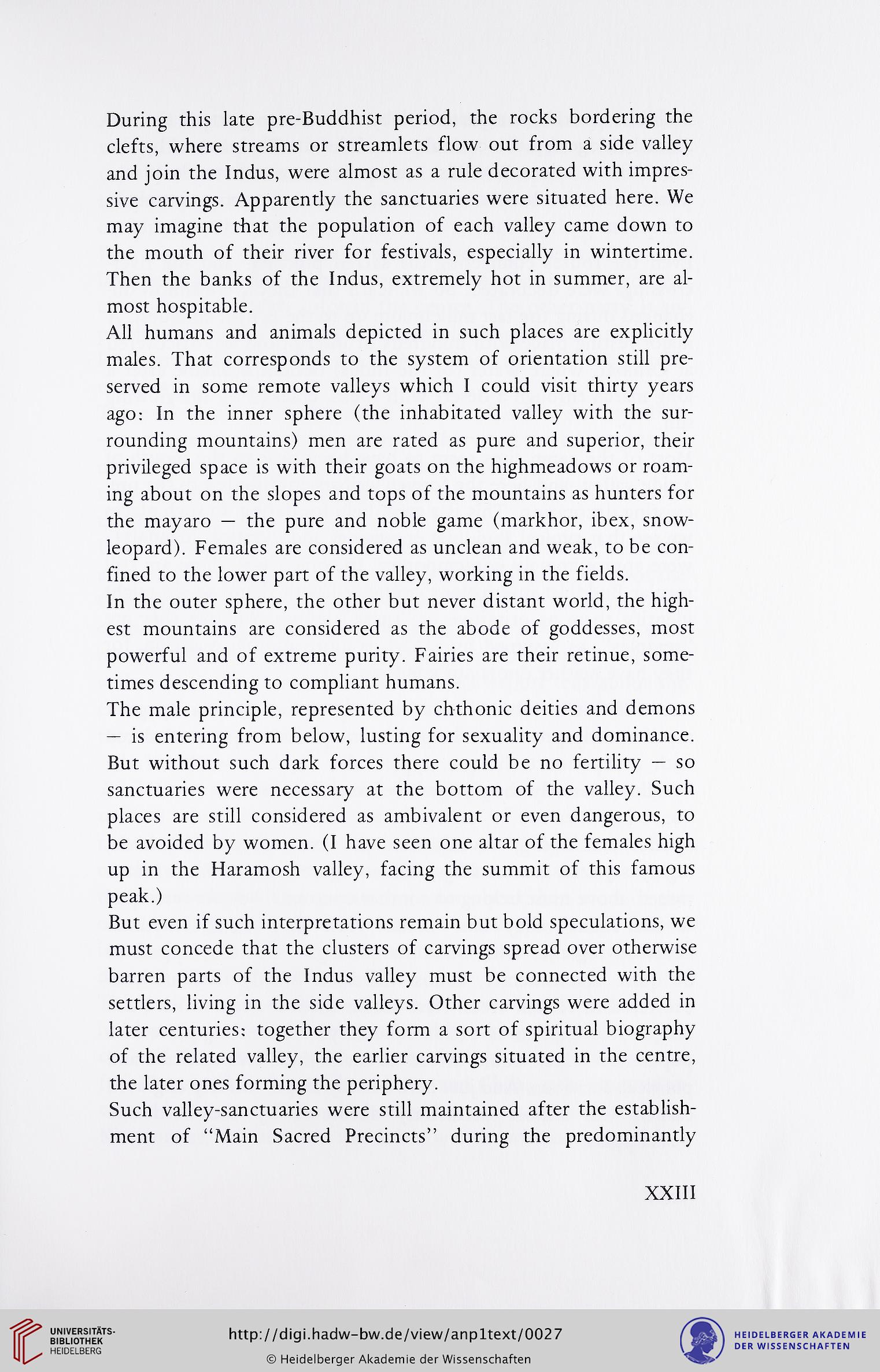During this late pre-Buddhist period, the rocks bordering the
clefts, where streams or streamlets flow out from a side valley
and join the Indus, were almost as a rule decorated with impres-
sive carvings. Apparently the sanctuaries were situated here. We
may imagine that the population of each valley came down to
the mouth of their river for festivals, especially in wintertime.
Then the banks of the Indus, extremely hot in summer, are al-
most hospitable.
All humans and animals depicted in such places are explicitly
males. That corresponds to the system of orientation still pre-
served in some remote valleys which I could visit thirty years
ago: In the inner sphere (the inhabitated valley with the sur-
rounding mountains) men are rated as pure and superior, their
privileged space is with their goats on the highmeadows or roam-
ing about on the slopes and tops of the mountains as hunters for
the mayaro — the pure and noble game (markhor, ibex, snow-
leopard). Females are considered as unclean and weak, to be con-
fined to the lower part of the valley, working in the fields.
In the outer sphere, the other but never distant world, the high-
est mountains are considered as the abode of goddesses, most
powerful and of extreme purity. Fairies are their retinue, some-
times descending to compliant humans.
The male principle, represented by chthonic deities and demons
— is entering from below, lusting for sexuality and dominance.
But without such dark forces there could be no fertility — so
sanctuaries were necessary at the bottom of the valley. Such
places are still considered as ambivalent or even dangerous, to
be avoided by women. (I have seen one altar of the females high
up in the Haramosh valley, facing the summit of this famous
peak.)
But even if such interpretations remain but bold speculations, we
must concede that the clusters of carvings spread over otherwise
barren parts of the Indus valley must be connected with the
settlers, living in the side valleys. Other carvings were added in
later centuries: together they form a sort of spiritual biography
of the related valley, the earlier carvings situated in the centre,
the later ones forming the periphery.
Such valley-sanctuaries were still maintained after the establish-
ment of "Main Sacred Precincts" during the predominantly
XXIII
clefts, where streams or streamlets flow out from a side valley
and join the Indus, were almost as a rule decorated with impres-
sive carvings. Apparently the sanctuaries were situated here. We
may imagine that the population of each valley came down to
the mouth of their river for festivals, especially in wintertime.
Then the banks of the Indus, extremely hot in summer, are al-
most hospitable.
All humans and animals depicted in such places are explicitly
males. That corresponds to the system of orientation still pre-
served in some remote valleys which I could visit thirty years
ago: In the inner sphere (the inhabitated valley with the sur-
rounding mountains) men are rated as pure and superior, their
privileged space is with their goats on the highmeadows or roam-
ing about on the slopes and tops of the mountains as hunters for
the mayaro — the pure and noble game (markhor, ibex, snow-
leopard). Females are considered as unclean and weak, to be con-
fined to the lower part of the valley, working in the fields.
In the outer sphere, the other but never distant world, the high-
est mountains are considered as the abode of goddesses, most
powerful and of extreme purity. Fairies are their retinue, some-
times descending to compliant humans.
The male principle, represented by chthonic deities and demons
— is entering from below, lusting for sexuality and dominance.
But without such dark forces there could be no fertility — so
sanctuaries were necessary at the bottom of the valley. Such
places are still considered as ambivalent or even dangerous, to
be avoided by women. (I have seen one altar of the females high
up in the Haramosh valley, facing the summit of this famous
peak.)
But even if such interpretations remain but bold speculations, we
must concede that the clusters of carvings spread over otherwise
barren parts of the Indus valley must be connected with the
settlers, living in the side valleys. Other carvings were added in
later centuries: together they form a sort of spiritual biography
of the related valley, the earlier carvings situated in the centre,
the later ones forming the periphery.
Such valley-sanctuaries were still maintained after the establish-
ment of "Main Sacred Precincts" during the predominantly
XXIII




